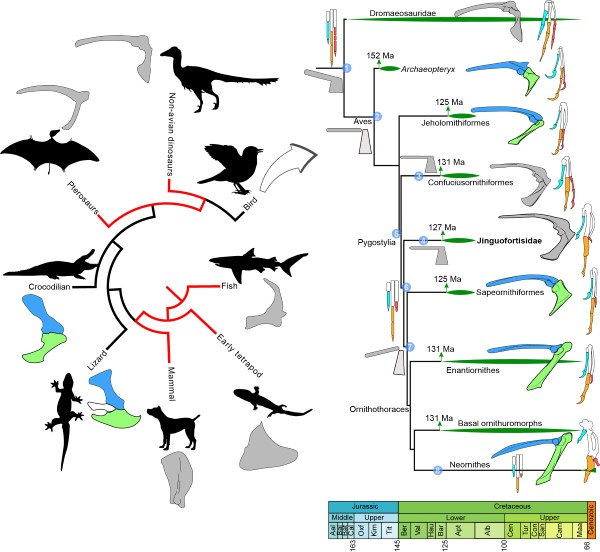Lived over 127 million years ago, it is called Jinguofortis perplexus and is a new species of primitive bird. The specimen, a hybrid of dinosaur and bird, inhabited northeastern China at the time and could now help scientists learn more about the evolution of birds.
Lived over 127 million years ago, it is called Jinguofortis perplexus and is a new species of primitive bird. The specimen, a hybrid of dinosaur and bird, inhabited northeastern China at the time and could now help scientists learn more about the evolution of birds.
This prehistoric bird of the early Cretaceous period retained some characteristics similar to those of a dinosaur but in fact it is a bird, one of the first to have populated the Earth. In a sense, birds are modern day dinosaurs. Despite numerous studies, it is difficult to say precisely where one ends and the others are definitively established. But the newly discovered bird mixes avian characteristics with some prehistoric "oddities", shedding new light on the evolution of birds and flight.
It is one of the most important fossil birds found in recent years. The remains of this species have been found in a 127 million year old fossil deposit. They were studied by researchers from the Institute of Vertebrate Paleontology and Paleoanthropology of the Chinese Academy of Sciences in Beijing, who examined in detail their skeleton and well-preserved feathers.
Evolutionary analysis of this primitive fossil bird shows that it is crucial in the evolution of flight, when the birds lost their long bony tail, developing a fan of feathers on their shortened tail.
Dr. Wang and his collaborators (Min Wang, Thomas Stidham and Zhonghe Zhou) have called this species extinct Jinguofortis perplexus. The name of the genus "Jinguofortis" is a dedication to female scientists from all over the world and derives from the Chinese word "jinguo" which means female warrior, and the Latin word "fortis" which means brave. In the evolutionary history of birds and flight, Jinguofortis perplexus, along with another lesser-known Chinese bird fossil called Chongmingia zhengi, forms the second oldest group of birds with a short bony tail.

This early Cretaceous fossil bird has a unique combination of traits. Explains Dr. Zhou:
"It has a jaw with small teeth like its theropod dinosaur relatives, a short bony tail that ends in a compound bone called a pygostyle (which evolved after the first known bird, Archeopteryx), and a third finger with only two bones unlike others. primitive birds ".
In fact, J perplexus exhibits some features we don't typically see in today's birds such as the toothed jaw instead of the beak but was still, technically, a bird, more specifically a short-tailed bird, or pygostyle. The study of this group as a whole has produced a great wealth of knowledge for paleontologists, as these creatures appear to mark the transition from the long, straight tails of dinosaurs to the small, fused, stubby tails that birds have today.
Why is this new species important? According to scientists, the modern flight apparatus of living birds has evolved through the gradual accumulation of features in feathers, muscles and bones over millions of years. This new bird fossil shows that the evolution of flight has been much more complex.
The study was published in Pnas.
READ also
- Scientists have discovered the strangest dinosaur that ever lived
- Feathered Dinosaur Tail Hidden in Amber: The Historical Discovery (PHOTO)
- Chick fossil discovered, sheds light on bird evolution
- Belone, the record-breaking bird hidden in amber for 100 million years
Francesca Mancuso


























